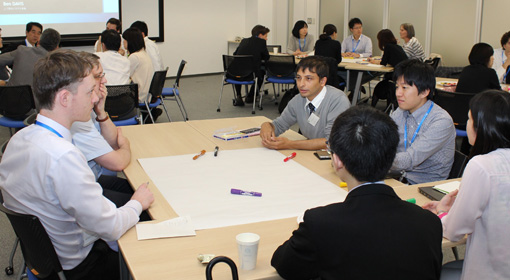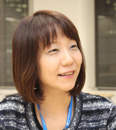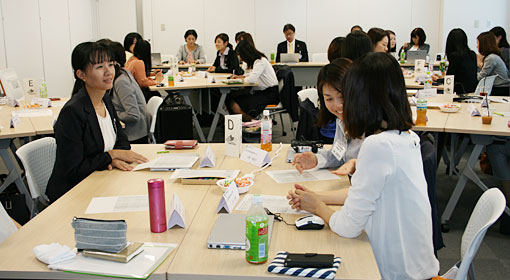Feature: Diversity at Chugai Today
As it seeks to become a top pharmaceutical company, Chugai places a priority on diversity, and in 2010 began working on a series of full-fledged diversity initiatives. In the five years since, what have we achieved, and what issues have become apparent? This feature offers a number of recent examples that describe the current state of diversity at Chugai.
By Promoting Diversity and Inclusion, Chugai is Providing Opportunities for a Diversity of Personnel to Succeed
A management working team headed by Chugai’s president was assembled and in 2010 began activities to promote gender diversity. In January 2012, we made the promotion of diversity management a key corporate priority, and have worked to address the issue in the years since. Also in 2012, our Human Resources Management Department. established a Diversity Office, which works to carry out initiatives from a variety of perspectives aside from gender, encompassing various nationalities, senior workers, outside experts, and others.
As the world changes dramatically both at home and abroad, building a flexible, strong organization has become a pressing issue. Bringing together employees with a variety of attitudes and from diverse backgrounds can encourage people to take on new challenges, helping to drive innovation. At Chugai, we are focused not on simply creating a situation in which diverse employees work together, but on a concept of diversity and inclusion in which employees stimulate one another, increasing the value of the organization’s output.
Example 1 : I want my presence to act as an opportunity for diversity promotion at Chugai
From Germany to Japan, a Major Challenge
I was working for a global drug development contract research organization (CRO), in charge of toxicity testing. I worked on projects for a variety of companies, which was both fun and very interesting, but I never really understood how my own work contributed to the broader development process.
For this and other reasons I was considering changing jobs. I’d always had an interest in foreign cultures in general, and living in a foreign country was something I’d been thinking about for many years. I was especially interested in Japanese culture and history, and on several business trips to Japan prior to joining Chugai, I’d been very impressed by Japan as a country, and by the Japanese people.
There are three reasons I chose to work at Chugai. First, in my previous job I’d been involved in two research projects for Chugai, and found I could relate to Chugai’s research process. Second, Chugai’s portfolio, with its specialization in biopharmaceuticals and anticancer agents, drew my interest. Third, I was looking for an equitable workplace environment with a friendly, productive atmosphere. After meeting with executives of the company, I knew instinctively that Chugai could offer what I was seeking. This is how I came to join Chugai in April of 2014.

Safety Assessment Department
Werner Frings
The Understanding and Cooperation of Others Created an Environment for Using English
Since I don’t speak much Japanese, before I joined the company I’d assumed that I’d be unable to participate in Japanese project discussions. Once I got here, I found that some of my colleagues spoke English quite well, and were eager to use their language ability, but I also noticed that others weren’t nearly as proficient. With everyone working so hard, they simply didn’t have the time or energy to spend using English. Given that so little information was available in English, I realized it would be difficult for me to do my job perfectly.
Still, I didn’t want to give up. Fortunately, my colleagues generously offered to translate relevant information into English, and did whatever else they could to help, including making English the standard language for meetings in which I participated. While I worked in the Safety Assessment Department, eventually a notice went out to other departments that all materials should at least be in English. More recently, English has become the standard language for monthly meetings in which other departments participate, and it was decided that Japanese would be allowed only when the discussion was too complex for English.
At the time, this situation made me very uncomfortable. I thought that my presence alone was inconveniencing my colleagues. One day, though, I realized that this represented an important change for the future of the company, and my own feelings began to change as well. I realized that with more people able to participate in international partnerships and discussions, our corporate value would improve, and with a more global work environment, more people who may not speak Japanese but are otherwise extremely talented might wish to join Chugai.
In that sense, I began to see my presence not as a hindrance to my colleagues, but as an opportunity for the company. Today, I feel as though more of my colleagues are making an effort to use English more frequently. There may be a long road ahead, but I think we’re moving in the right direction.
Chugai is Taking Solid Steps to Advance Diversity Promotion
I think diversity grows out of three steps. The first step is not to think of differences in terms of positive and negative values, but to realize that everyone is different. This awareness of differences advances when a company hires people like me, who are clearly different from the Japanese. Until now, Chugai didn’t have very many foreign employees. But as the company promotes the hiring of more non-Japanese with real working experience, Chugai has begun to change.
The next step is to clarify individuals’ strengths and weaknesses, as a way of leveraging their differences. The company must then advance those strengths, and eventually find the right workplace and career opportunities for each individual. Chugai has already issued a statement setting out goals for its employees to make an effort in this area, and encouraging them to do so.
The last step is to learn from individual differences. This means recognizing that what’s good for one individual may not be good for another, but it’s also important to recognize this as an opportunity. I think Chugai is already doing well in this area, too. This is because most of its employees work hard at attempting to accept opinions and thoughts that are different from their own, and are proactive about trying to learn from others.
One method Chugai needs to emphasize to further promote diversity is to increase opportunities to use English, even if this may be inconvenient. This will not only build stronger ties with non-Japanese employees, but is useful in better understanding employees of affiliates such as Roche and Genentech. I think there are many things we can learn from them, and many things they, in turn, can learn from Chugai’s employees. Allowing employees of Chugai to gain a better understanding of English will make that process easier.

General Manager, Safety Assessment Department
Shuichi Chiba
Since Mr. Frings had worked for a major overseas CRO, we had no concerns about his job skills. But his Japanese wasn’t very good, so the issue was whether he could communicate freely in the workplace and manage a variety of procedures on his own.
One of the first things we did was to establish English as the language for meetings where Mr. Frings would be present--at the least either for documentation or for speaking. This put a considerable burden on some of our workers, but today most of our members are able to give presentations and handle question and answer sessions in English without a problem.
At the same time, many of our meetings with other departments are conducted solely in Japanese, and on those occasions a Japanese colleague accompanies Mr. Frings to provide explanations. Still, I think it must be difficult for him to understand the details when it comes to more specialized topics. In this area, I think we need to call for further cooperation from those involved.
Mr. Frings has extensive experience, particularly in biopharmaceutical toxicity assessments, and he brings to the workplace a new perspective and a new way of interpreting data. He has also expanded our network with toxicity specialists outside of Japan, giving us even greater access to information useful in developing new antibody drugs created using proprietary technology. The addition of a team member from a different background has brought diversity to our approach to data assessment, and I think that has enabled us to make better assessments and decisions.
Example 2 : Forums Held to Deepen Employees’ Multicultural Understanding
A new diversity promotion initiative that began in 2015 is the Inclusion and Diversity by Embracing and Accepting (I.D.E.A.) forum, and opportunity to exchange opinions about multicultural understanding. The goal of this endeavor is to further mutual understanding between Chugai’s non-Japanese and Japanese staff, and to improve the work environment by enabling employees to share their experiences and knowledge.
The forum was held once in September of 2015, and twice in November; going forward, we plan to hold similar forums about once a quarter. Employees who have worked in other cultures give presentations about things they realized through their own experiences, and later, the participants break up into teams to engage in group discussion.
28 people participated in the second I.D.E.A. forum held on November 19. Twelve of them were non-Japanese employees, a diverse group of nationalities that included China, South Korea, Nepal, the U.S., England and Australia.
At the forum, two employees--one non-Japanese, one Japanese--presented talks on the beauty and difficulty of using Japanese polite speech, and on the status of diversity management at Roche.

I.D.E.A. Forum
From the individual in charge of planning the I.D.E.A. Forum


Corporate Social Responsibility Department, Corporate Ethics Group
Robert Mark
I am responsible for working on the English version of the Chugai BCG and human rights training. The text for employees contained a number of Japanese phrases like “Ninin Sankyaku; working together” that could be difficult for non-Japanese to understand, and I felt there was a need for additional explanation and revision. I thought more needed to be done to understand the differences between Japanese culture and the culture of other countries. This forum came about when I asked my manager if there weren’t some way to establish an opportunity for non-Japanese employees to get together and speak frankly, rather than dealing with these issues alone. The first forum, held in September and conducted in English, was attended by 11 non-Japanese and 22 Japanese employees, and was a huge success. Several of the Japanese participants, however, commented that some of the English expressions were too difficult for them to understand. The second forum was held in Japanese, but this time we asked the participants ahead of time to speak in simple words and phrases that would be easy to understand. This made me strongly aware of the need to use language that is as easy as possible for the listener to understand when Japanese and non-Japanese employees communicate in the workplace.
I am in charge of the forum’s administration and also serve as emcee. It’s very rewarding work, since every session exceeds my expectations, and the participants all seem happy with the results.


Human Resources Management Department., Global HR Group
Setsuko Inamura
When the CSR Department came to us with this idea, the Human Resources Management Department. had just been thinking about creating a networking opportunity for our non-Japanese employees, so we immediately decide to offer our help in launching the forum. In May of 2015, we held a pilot forum as a kind of trial run, which was attended by 15 non-Japanese and six Japanese employees.
Before we began, there was some uncertainty about what kind of opinions would come out and what kind of atmosphere would prevail, but the forum itself completely blew away such concerns. We were relieved to find that the participants were very happy with the forum, and level many positive comments on the questionnaires they filled out afterward.
The Human Resources Management Department. expects that this forum will have a positive impact on efforts to promote diversity and inclusion, and is giving its support to such independent employee activities. While both departments work together to run the forums, I attend the group discussions as an individual participant, and always enjoy talking to different people and learning about a wide variety of attitudes and values. For the future, we are thinking of ways to offer employees in more remote locations the chance to participate as well, by using the web and holding forums at other sites.
Example 3 : From Gender Diversity to True Inclusion!
An Effort Designed Around Building Programs, Enlightening Staff, and Establishing the Right Environment
The presence of role models has been successful in spreading a balance between life events and work
Before Chugai began its full-fledged efforts to promote diversity, female medical representatives (MRs) with the company regularly used marriage or childbirth as an opportunity to leave their jobs.
Because this early turnover among female MRs represented a significant loss both for the company and for the individual’s own growth, we issued the message that an organization which recognizes the individual and enables each person to fully enjoy their work leads to growth and success for the individual and the organization. The Marketing & Sales Human Resource Management Department then began a full-fledged effort to create an environment in which female MRs could continue to work. This involved three key components: (1) building programs, (2) enlightening staff, and (3) establishing the right workplace environment.
First, in terms of building programs, we introduced the short-time work for childcare system (flextime work) for MRs, a program that had already been introduced for head office and branch staff. We also worked with the Human Resources Management Department. to revamp other programs, including a transfer assistance plan to allow MRs to live with their spouses after marriage.
Next, as part of our enlightening activities, we held a variety of events designed to raise awareness among female MRs and develop role models. These included forums for female MRs and other female employees, branch office subcommittees and our “Happy Career Cafe.”
Along with these activities, we worked to encourage the understanding of supervisors and colleagues, and to revitalize the organization, began focusing on the third component, establishing the right workplace environment. We focused especially on changing attitudes among management through diversity management training.
By promoting these three core activities, the ratio of married female MRs has risen significantly, while turnover among female MRs has fallen.
Behind this increased awareness among female MRs that they can continue to work even in the face of live events such as marriage, childbirth, and childcare is the significant contribution made by role models who utilize these programs to balance work with marriage, childbirth and childcare. This achievement has come about in part because the realization that life events need not prevent one from continuing to work, that in fact continuing to work is perfectly normal, has begun to take root among the supervisors, male colleagues and others who work with these women.
Making the success of diverse personnel an everyday thing
Another major issue for Chugai’s Marketing & Sales Division is how to create an environment in which employees above the age of 55 can make even greater use of their talents. At Chugai, we offer employees who have turned 55 the option of either continuing to work as full-time permanent employees until the age of 60, or retiring at 55 and then signing on again to work until age 65 as contract employees. We believe that enabling senior employees, with their extensive experience and skills, to fully enjoy their work provides a trigger for revitalizing the workplace.
The ultimate goal of these activities is to see that diversity is no longer treated as a special word. Diversity promotion aims to create a situation in which it is perfectly normal for a diverse workforce to make the most of their individual capabilities and characteristics, but it is a long journey, one that cannot be completed overnight. To achieve that goal, it is essential that we further the understanding of all employees by continuing “building programs, “enlightening staff”, and “establishing the right workplace environment.”
In the Marketing & Sales Division, we are addressing other issues such as the success of senior employees and encouraging men to take paternity leave by first creating role models. We believe that by allowing other employees to see these men and women maintaining a work/life balance while still enjoying their jobs, many of them will gain a greater understanding of the true meaning of “diversity and inclusion,” and we continue to promote diversity with that goal in mind.

Branch Female MR Forum
